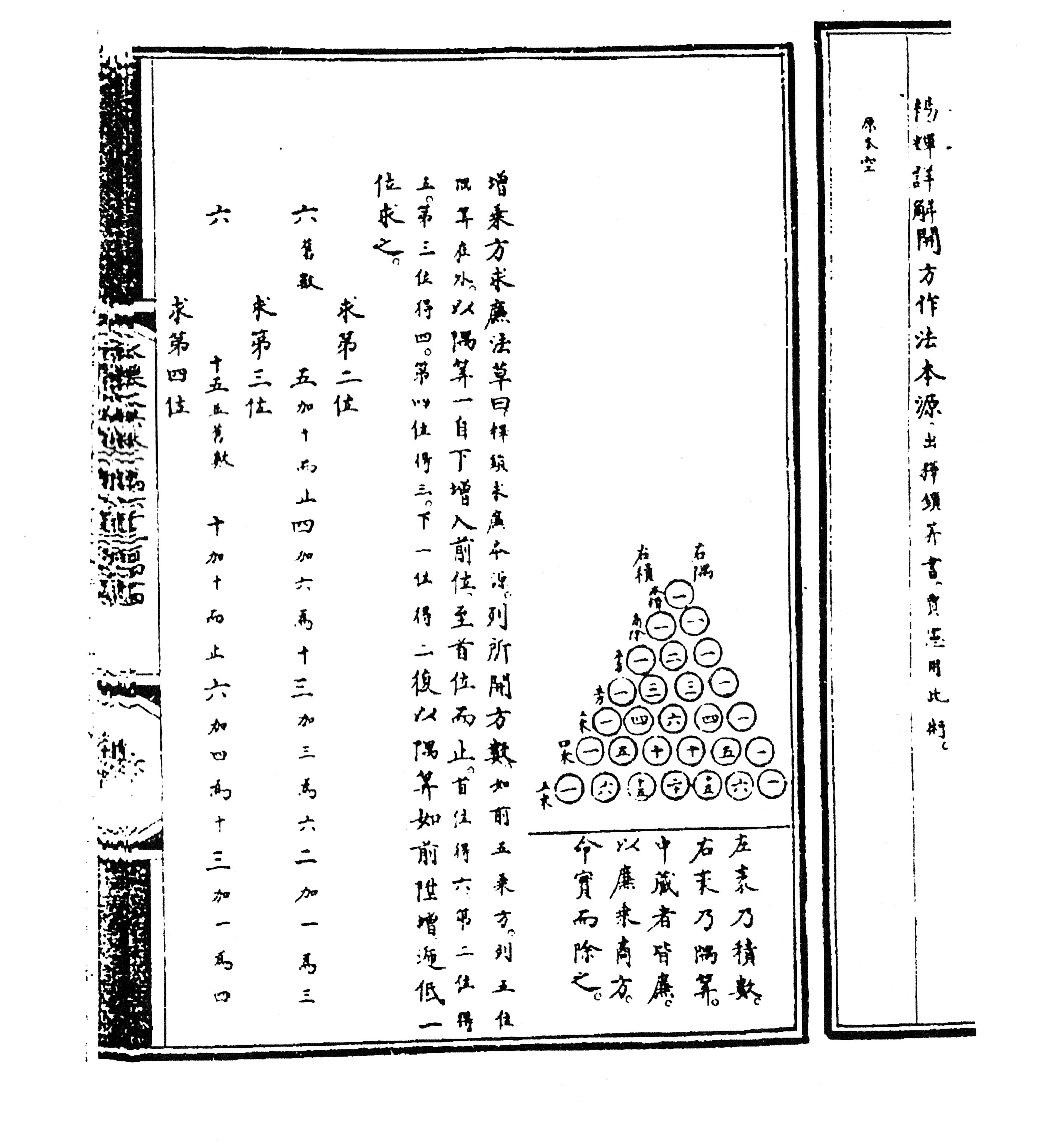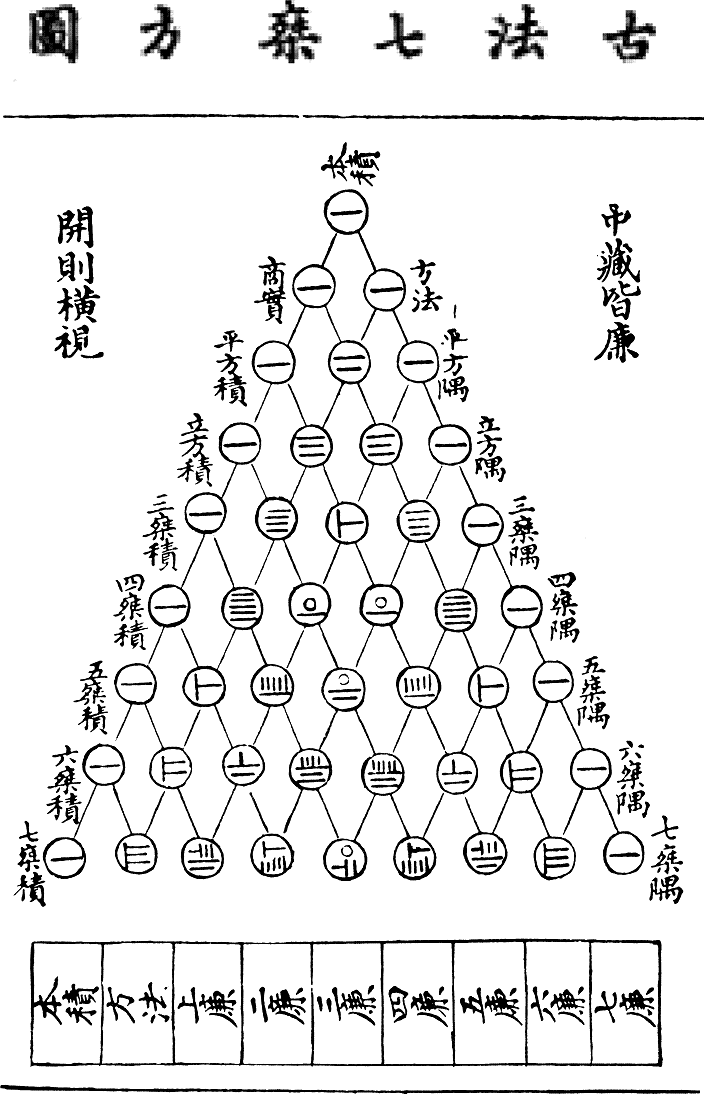|
Jia Xian
Jia Xian (; ca. 1010–1070) was a Chinese mathematician from Kaifeng of the Song dynasty. Biography According to the history of the Song dynasty, Jia was a palace eunuch of the Left Duty Group. He studied under the mathematician Chu Yan, and was well versed in mathematics, writing many books on the subject. Jia Xian described the Pascal's triangle (Jia Xian triangle) around the middle of the 11th century, about six centuries before Pascal. Jia used it as a tool for extracting square and cubic roots. The original book by Jia entitled ''Shi Suo Suan Shu'' was lost; however, Jia's method was expounded in detail by Yang Hui Yang Hui (, ca. 1238–1298), courtesy name Qianguang (), was a Chinese mathematician and writer during the Song dynasty. Originally, from Qiantang (modern Hangzhou, Zhejiang), Yang worked on magic squares, magic circles and the binomial theo ..., who explicitly acknowledged his source: "My method of finding square and cubic roots was based on the Jia Xi ... [...More Info...] [...Related Items...] OR: [Wikipedia] [Google] [Baidu] |
Jia (surname)
Jiǎ () is a Chinese surname, surname. Chia is the corresponding Wade-Giles romanization, which is commonly used in Taiwan. Ka is the corresponding Cantonese-based romanization, which is used in Hong Kong and other Cantonese-speaking regions. Notable people with Jia as a surname Historical figures * Jia Yi (賈誼; 200–169 BCE), official of the Han dynasty * Jia Kui (scholar) (賈逵; 30–101), scholar and astronomer of the Eastern Han dynasty * Jia Xu (賈詡; 147–223), official of the Cao Wei state * Jia Kui (general) (賈逵; 174–228), general of Cao Wei state * Jia Chong (賈充; 217–282), general of the Jin dynasty * Jia Nanfeng (賈南風; 257–300), empress of the Jin dynasty * Huiyuan (Buddhist), Huiyuan (慧遠; 334–416), Buddhist teacher of the Jin dynasty * Jia Dan (賈耽; 730–805), official of the Tang dynasty * Jia Dao (賈島; 779–843), poet of the Tang dynasty * Jia Su (賈餗; died 835), official of the Tang dynasty * Jia Xian (贾宪; 1010–1070) ... [...More Info...] [...Related Items...] OR: [Wikipedia] [Google] [Baidu] |
Yang Hui
Yang Hui (, ca. 1238–1298), courtesy name Qianguang (), was a Chinese mathematician and writer during the Song dynasty. Originally, from Qiantang (modern Hangzhou, Zhejiang), Yang worked on magic squares, magic circles and the binomial theorem, and is best known for his contribution of presenting Yang Hui's Triangle. This triangle was the same as Pascal's Triangle, discovered by Yang's predecessor Jia Xian. Yang was also a contemporary to the other famous mathematician Qin Jiushao. Written work The earliest extant Chinese illustration of ' Pascal's triangle' is from Yang's book ''Xiangjie Jiuzhang Suanfa'' ()Fragments of this book was retained in the Yongle Encyclopedia vol 16344, in British Museum Library of 1261 AD, in which Yang acknowledged that his method of finding square roots and cubic roots using "Yang Hui's Triangle" was invented by mathematician Jia XianNeedham, Volume 3, 134-137. who expounded it around 1100 AD, about 500 years before Pascal. In his book (n ... [...More Info...] [...Related Items...] OR: [Wikipedia] [Google] [Baidu] |
Song Dynasty Science Writers
A song is a musical composition intended to be performed by the human voice. This is often done at distinct and fixed pitches (melodies) using patterns of sound and silence. Songs contain various forms, such as those including the repetition and variation of sections. Written words created specifically for music, or for which music is specifically created, are called lyrics. If a pre-existing poem is set to composed music in classical music it is an art song. Songs that are sung on repeated pitches without distinct contours and patterns that rise and fall are called chants. Songs composed in a simple style that are learned informally "by ear" are often referred to as folk songs. Songs that are composed for professional singers who sell their recordings or live shows to the mass market are called popular songs. These songs, which have broad appeal, are often composed by professional songwriters, composers, and lyricists. Art songs are composed by trained classical composers fo ... [...More Info...] [...Related Items...] OR: [Wikipedia] [Google] [Baidu] |
Song Dynasty Eunuchs
A song is a musical composition intended to be performed by the human voice. This is often done at distinct and fixed pitches (melodies) using patterns of sound and silence. Songs contain various forms, such as those including the repetition and variation of sections. Written words created specifically for music, or for which music is specifically created, are called lyrics. If a pre-existing poem is set to composed music in classical music it is an art song. Songs that are sung on repeated pitches without distinct contours and patterns that rise and fall are called chants. Songs composed in a simple style that are learned informally "by ear" are often referred to as folk songs. Songs that are composed for professional singers who sell their recordings or live shows to the mass market are called popular songs. These songs, which have broad appeal, are often composed by professional songwriters, composers, and lyricists. Art songs are composed by trained classical composers fo ... [...More Info...] [...Related Items...] OR: [Wikipedia] [Google] [Baidu] |
Medieval Chinese Mathematicians
In the history of Europe, the Middle Ages or medieval period lasted approximately from the late 5th to the late 15th centuries, similar to the post-classical period of global history. It began with the fall of the Western Roman Empire and transitioned into the Renaissance and the Age of Discovery. The Middle Ages is the middle period of the three traditional divisions of Western history: classical antiquity, the medieval period, and the modern period. The medieval period is itself subdivided into the Early, High, and Late Middle Ages. Population decline, counterurbanisation, the collapse of centralized authority, invasions, and mass migrations of tribes, which had begun in late antiquity, continued into the Early Middle Ages. The large-scale movements of the Migration Period, including various Germanic peoples, formed new kingdoms in what remained of the Western Roman Empire. In the 7th century, North Africa and the Middle East—most recently part of the Easte ... [...More Info...] [...Related Items...] OR: [Wikipedia] [Google] [Baidu] |
11th-century Chinese Mathematicians
The 11th century is the period from 1001 ( MI) through 1100 ( MC) in accordance with the Julian calendar, and the 1st century of the 2nd millennium. In the history of Europe, this period is considered the early part of the High Middle Ages. There was, after a brief ascendancy, a sudden decline of Byzantine power and a rise of Norman domination over much of Europe, along with the prominent role in Europe of notably influential popes. Christendom experienced a formal schism in this century which had been developing over previous centuries between the Latin West and Byzantine East, causing a split in its two largest denominations to this day: Roman Catholicism and Eastern Orthodoxy. In Song dynasty China and the classical Islamic world, this century marked the high point for both classical Chinese civilization, science and technology, and classical Islamic science, philosophy, technology and literature. Rival political factions at the Song dynasty court created strife amongst t ... [...More Info...] [...Related Items...] OR: [Wikipedia] [Google] [Baidu] |
Karine Chemla
Karine Chemla (born in Tunis February 8, 1957) is a French historian of mathematics and sinologist who works as a director of research at the Centre national de la recherche scientifique (CNRS). She is also a senior fellow at the New York University Institute for the Study of the Ancient World. She was elected a Member of the American Philosophical Society in 2019. Education Chemla studied at Paris Diderot University and the École normale supérieure de jeunes filles, earning an agrégation in mathematics in 1978 and a diploma of advanced studies in 1979. At this time, her work was in pure mathematics. However, in 1980, influenced by the work of Ilya Prigogine, she won a Singer–Polignac scholarship to travel to China and study the history of Chinese mathematics.. Returning to France, she earned her Ph.D. in the history of mathematics from Paris 13 University in 1982, and began working for CNRS at that time.. Contributions Chemla's research interests include Chinese mathemati ... [...More Info...] [...Related Items...] OR: [Wikipedia] [Google] [Baidu] |
Yongle Encyclopedia
The ''Yongle Encyclopedia'' () or ''Yongle Dadian'' () is a largely-lost Chinese ''leishu'' encyclopedia commissioned by the Yongle Emperor of the Ming dynasty in 1403 and completed by 1408. It comprised 22,937 manuscript rolls or chapters, in 11,095 volumes. Fewer than 400 volumes survive today, comprising about 800 chapters (rolls), or 3.5 percent of the original work. Most of it was lost in the 2nd half of the 19th century, in the midst of events as Second Opium War, the Boxer Rebellion and subsequent social unrests. Its sheer scope and size made it the world's largest general encyclopedia until it was surpassed by Wikipedia in late 2007, nearly six centuries later. Background Although known for his military achievements, the Yongle Emperor was an intellectual who enjoyed reading.Christos, Lauren. "The Yongle Dadian: The Origin, Destruction, Dispersal, and Reclamation of a Chinese Cultural Treasure." ''Journal of Library and Information Science'' 36, no. 1 (April 2010): 85. ... [...More Info...] [...Related Items...] OR: [Wikipedia] [Google] [Baidu] |
Cubic Root
In mathematics, a cube root of a number is a number such that . All nonzero real numbers, have exactly one real cube root and a pair of complex conjugate cube roots, and all nonzero complex numbers have three distinct complex cube roots. For example, the real cube root of , denoted \sqrt , is , because , while the other cube roots of are -1+i\sqrt 3 and -1-i\sqrt 3. The three cube roots of are :3i, \quad \frac-\fraci, \quad \text \quad -\frac-\fraci. In some contexts, particularly when the number whose cube root is to be taken is a real number, one of the cube roots (in this particular case the real one) is referred to as the ''principal cube root'', denoted with the radical sign \sqrt The cube root is the inverse function of the cube function if considering only real numbers, but not if considering also complex numbers: although one has always \left(\sqrt \right)^3 =x, the cube of a nonzero number has more than one complex cube root and its principal cube root may ... [...More Info...] [...Related Items...] OR: [Wikipedia] [Google] [Baidu] |
Yanghui Triangle
In mathematics, Pascal's triangle is a triangular array of the binomial coefficients that arises in probability theory, combinatorics, and algebra. In much of the Western world, it is named after the French mathematician Blaise Pascal, although other mathematicians studied it centuries before him in India, Persia, China, Germany, and Italy. The rows of Pascal's triangle are conventionally enumerated starting with row n = 0 at the top (the 0th row). The entries in each row are numbered from the left beginning with k = 0 and are usually staggered relative to the numbers in the adjacent rows. The triangle may be constructed in the following manner: In row 0 (the topmost row), there is a unique nonzero entry 1. Each entry of each subsequent row is constructed by adding the number above and to the left with the number above and to the right, treating blank entries as 0. For example, the initial number of row 1 (or any other row) is 1 (the sum of 0 and 1), whereas the numbers 1 and 3 in ... [...More Info...] [...Related Items...] OR: [Wikipedia] [Google] [Baidu] |





